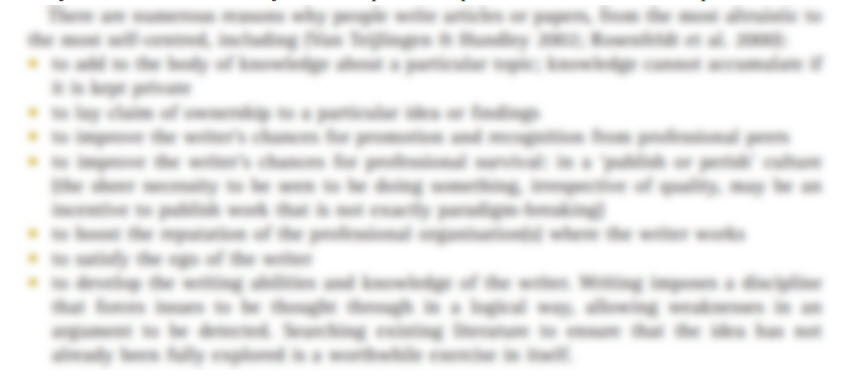
An abstract is typically the summary or overview of a scientific paper, thesis or report. The purpose of the abstract is to give your reader a complete summary of your entire project. As there is a never-ending supply of papers and reports to read, you only have two chances to engage your reader and to convince them to keep reading. The first is the title (and the keywords) and the second is the abstract.
A well-written abstract will maximise the chances of your document being read, understood and even enjoyed. If writing a research paper, a well-written abstract will maximise your publication success. Not only will reviewers appreciate a good abstract, it may be the only part of the paper they are sent when invited to review a paper.
This focus of this article is to highlight what is commonly wrong with abstracts. Please note: The relevancy of some issues raised here might depend upon your discipline or document type. For example, some academic journals do not require abstracts at all or only require a very brief project overview.
These common mistakes are not listed in any particular order and some overlap:
1. Not writing a summary
The abstract should be a complete, succinct summary of your entire project. Summarising is being able to identify and highlight key points using as few words as possible.
2. Not paraphrasing your own work
Paraphrasing is when you use your own words to convey meaning from another source, with the aim of improving clarity. Paraphrasing often includes summarising. One common mistake is to copy entire sentences from different parts of the paper into the abstract. This is not summarising or paraphrasing.

3. Not summarising your entire project
A common mistake is to only include certain parts of the project in the abstract. If your paper is structured into Introduction, Methods, Results and Discussion sections, then your abstract includes a summary of each section, often written as a complete paragraph or with headings. If the abstract lacks key information, for example the aim or the conclusions, the reader may not appreciate the strength of importance of your project and not be convinced to keep reading. Don’t assume your reader will search through your document for this information if they can’t find it in the abstract.
4. Using the abstract as a de facto Introduction or Discussion
After writing important introductory and conclusion explanations in the abstract, some authors then don’t include these details in the body of the document, fearing it will look repetitive. This can happen if the abstract is written before designing the rest of the document. Although drafting an abstract in the early stages of writing is a good idea, it is best to finalise your abstract when you have finished the rest of your document.
5. Including too much (or not enough) background
If the abstract is considered a de facto introduction, too much background may be included. Alternatively, a brief summary of the background might be omitted if the author assumes the audience is completely familiar with the project topic and the background. Never assume your reader knows your topic or project as thoroughly as you do; some of you readers might, but they will still need this information to appreciate what your document is about.
6. Including too many (or not enough) methods
A brief summary of the methods or procedure is important as they are a key component of any project. Given the potential complexity and diversity of a scientific study, it is easy to add too much detail about methods; an example is the unnecessary listing of all data collection instruments and their brand names. The following example from a research paper abstract is a concise summary of the methods. “Methods: We systematically reviewed the literature and meta-analyzed risk estimates from longitudinal studies reporting the association of coronary heart disease (CHD) or heart failure (HF) with risk of dementia.” Wolters F.J. et al. (2018)

7. Not explaining what your results mean
As your abstract should include a summary of all parts of your project, this includes a summary of the discussion or conclusion of your study. Some authors omit interpreting their results, expecting the reader to wait until they have read the entire document. They may not.
8. Including citations, abbreviations and detailed measurements
Standard convention is to avoid writing abbreviations, detailed measurements or citations in an abstract. In some cases, and in some disciplines, it may be difficult to avoid using abbreviations if they are used as terms, are not written in any other format, difficult to write in full or impractical to leave out.
9. Including information not presented in the paper
It may be tempting to include extra information that is not in the rest of the document but this is misleading. Stick to your key aim.
10. Not following the Instructions to Authors of your target journal
A journals’ Instructions to Authors are just that: instructions; they are not suggestions or simply good ideas, nor are they meant to replace a science style guide. Depending upon the extent of this omission, not following a journal’s Instructions to Authors can dramatically increase the likelihood your paper will instantly returned for further changes.
11. Not including keywords
Keywords of your study are essential to ensure that your paper is correctly indexed and so your document will be visible in different search engines. Some authors assume this step is not necessary, assuming that all terms will be visible. Keywords “help promote an article’s visibility within the publications iceberg”.
Remember:
- Don't assume your readers know everything you do.
- Don't assume all published papers have good abstracts.
- Seek feedback before finalising your later drafts.
© Dr Marina Hurley 2020 www.writingclearscience.com.au
Any suggestions or comments please email info@writingclearscience.com.au
Find out more about our new online course...
SUBSCRIBE to the Writing Clear Science Newsletter
to keep informed about our latest blogs, webinars and writing courses.





